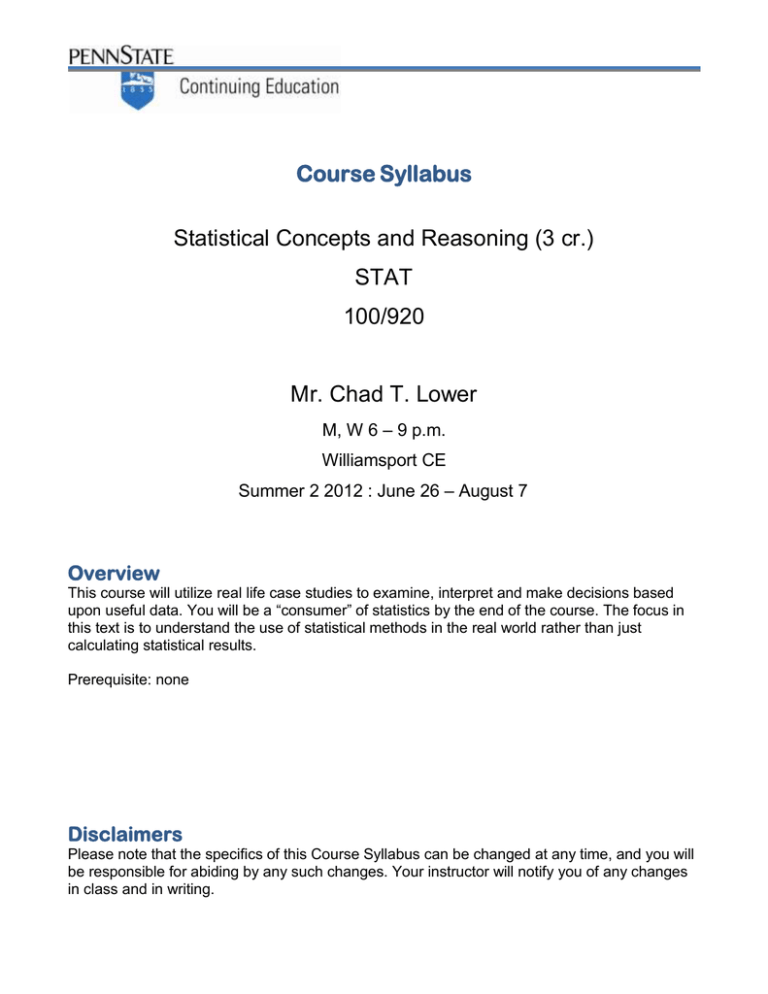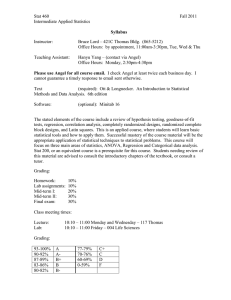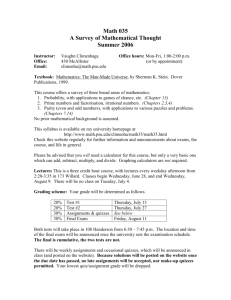Course Syllabus Statistical Concepts and Reasoning (3 cr.) STAT
advertisement

Course Syllabus Statistical Concepts and Reasoning (3 cr.) STAT 100/920 Mr. Chad T. Lower M, W 6 – 9 p.m. Williamsport CE Summer 2 2012 : June 26 – August 7 Overview This course will utilize real life case studies to examine, interpret and make decisions based upon useful data. You will be a “consumer” of statistics by the end of the course. The focus in this text is to understand the use of statistical methods in the real world rather than just calculating statistical results. Prerequisite: none Disclaimers Please note that the specifics of this Course Syllabus can be changed at any time, and you will be responsible for abiding by any such changes. Your instructor will notify you of any changes in class and in writing. Instructor Introduction Biography I have a Master’s of Science degree in Mathematics from Shippensburg University. Upon completion of my degree, I taught at Ship as an adjunct for one semester. They offered me a position for the next year, but I turned them down and joined Teach for America. While in TFA, I taught in the Houston Independent School District for a summer, then in Detroit Public schools for three years. While teaching high school math and social studies, I took courses at Marygrove College to earn my Michigan Teacher’s Certification in Secondary Mathematics and Chemistry. I then went on to teach math at West Virginia University as a GTA while taking classes and working as a statistician for the CDC/NIOSH on mine safety data. While at WVU, I took the PRAXIS for Mathematics: Content Knowledge, Chemistry: Content Knowledge, and Principles of Learning and Teaching: Grades 7 – 12 earning the ETS Recognition of Excellence for all three tests. I applied and obtained my Teacher’s Certification in Pennsylvania before obtaining a full-time position with the Pennsylvania College of Technology, which brought me to the Williamsport area. In addition to teaching at Penn State, I work as an Instructional Supervisor at The Keystone School and I also teach Motorcycle Safety Classes through the PA Motorcycle Safety Program. Beyond the academic, I enjoy reading and spending time with my wife and kiddos. I am an avid blood donor and a member of Lifetree Church in Jersey Shore. Recently, I have become the CubMaster for Pack 12 in Williamsport. Contact Information Email: chad.lower@zoho.com (emergency clower@keystonehighschool.com) Phone: 570-322-5771 FAX: 570-320-2447 Home Phone: 570-322-1570 (emergency 570-394-5618) Website: Building & Room: Watertower Square Complex Campus Address: 1020 Commerce Park Dr, STE 2B; Williamsport, PA 17701 Office Hours M, W 5:30 – 6 p.m. Other times by appointment. Extenuating Circumstances My intention is to be at every class about 5–10 minutes early. On the rare occurrence that class is cancelled, an email will be sent to you as soon as possible. I will also follow up with at least one email to clarify what you should do in my absence and update any future assignments if need be. Chad T. Lower STAT 100 – Statistical Concepts and Reasoning Page 2 Course Objectives The objective of this course is to introduce the student to statistical reasoning and interpretation of data analysis. By the end of the course, students will be proficient with statistical concepts, understand written reports based on statistical evidence, and become a wise consumer of statistical based arguments. Unit Objectives 1. Unit 1 a. b. c. d. e. 2. Unit 2 a. b. c. d. e. f. g. 3. Unit 3 a. b. c. d. e. f. g. h. Chad T. Lower 1 The Benefits and Risks of Using Statistics 3 Measurements, Mistakes, and Understanding 7 Summarizing and Displaying Measurement Data 8 Bell-Shaped Curves and Other Shapes 4 How to get a good sample 9 Plots, Graphs, and Pictures 12 Relationships Between Categorical Variables 13 Statistical Significance for tables 10 Relationships Between Measurement Variables 11 Relationships Can Be Deceiving 16 Understanding Probability and Long-Term Expectations 18 When Intuition Differs from Relative Frequency 5 Experiments and Observational Studies 19 The Diversity of Samples from the Same Population 20 Estimating Proportions with Confidence 21 The Role of Confidence Intervals in Research 2 Reading the News 22 Rejecting Chance—Testing Hypothesis in Research 23 Hypothesis Testing—Examples and Case Studies 24 Significance, Importance, and Undetected Differences STAT 100 – Statistical Concepts and Reasoning Page 3 Course Materials Required Texts Utts, Jessica M. (2005) Seeing Through Statistics (3 ed.) Belmont, CA: Brooks/Cole, Cengage Learning. Recommended Materials A three ring binder for notes and handouts, scientific calculator ANGEL This course utilizes ANGEL, Penn State’s online course management system. For information on using ANGEL, please refer to: http://www.berks.psu.edu/StudentServices/IT/ANGELabout.htm or at: http://php.scripts.psu.edu/dept/iit/hbg/facultycenter/TeachResource/handout doc/Guide for Students2006.pdf. The ANGEL website is located at http://cms.psu.edu Hardware/Software Requirements Operating System Windows 2000, ME, or XP Macintosh OS X (10.2 or higher) Processor 500 MHz or higher Memory 128 MB of RAM Hard Drive Space 500 MB free disk space Browser Mac OS X: Firefox 1.0 or higher Windows: Firefox 1.0 or higher Note: Cookies, Java, and JavaScript must be enabled. Pop-up blockers should be configured to permit new windows from Penn State web sites.Due to nonstandard handling of CSS, JavaScript and caching, we do not recommend using Internet Explorer 6 as your browser. Plug-ins Adobe Reader [Download from Adobe] Flash Player [Download from Adobe] Additional Software Microsoft Office, iWork, or Open Office Internet Connection broadband (cable or DSL) connection required Printer graphics-capable printer CD-ROM required Sound Card and Speakers required Monitor 15" monitor (1024 x 768 resolution) Chad T. Lower STAT 100 – Statistical Concepts and Reasoning Page 4 Academic Requirements Expectations and Course Policies Attendance: You are responsible both for all the material covered in class discussions as well as for the readings. Frequent absences will negatively impact your performance. "A student should attend every class for which the student is scheduled and should be held responsible for all work covered in the courses taken." (See Policies and Rules for Students, Class Attendance (42-27) on the PSU website at http://www.psu.edu/ufs/policies) Assignments: All assignments are due on the dates specified on the syllabus. The University has careful policies about your rights and responsibilities in the case of emergency and illness. Please, be familiar with them and do not try to abuse them. Work outside the classroom is essential for student success. Homework will be collected at four different times throughout the semester. Those times will be unannounced. The grade for that homework will come from completeness and the correctness of a few selected problems. The final project will be an ongoing work throughout the semester. The lectures will help develop the project into a finished product by the last class. During the last class the projects will be presented. More details on the project will be handed out in class. Examinations: Conflict and makeup exams will only be given to those individuals with official University sanctioned absences. You must give advance notice if possible. To be eligible for a make-up, you must present a WRITTEN REQUEST, which outlines the reason for your absence from the exam. Please refer to the University Grading Policy for Undergraduate and Graduate courses for additional information about University grading policies. Exam dates are listed on in the schedule, and cover the material from the last testing date. All exams will be conducted during regularly scheduled class time. The final exam will cover all information contained within the class. Materials, content and exam format will be announced prior to each exam. The instructor reserves the right to alter the exam format as deemed necessary. Tests will be comprehensive on the chapters listed. On test day, you will need a pencil/pen, calculator, and one 8.5”x11” sheet of paper with any notes you can fit on it. The final will be open notebook. Chad T. Lower STAT 100 – Statistical Concepts and Reasoning Page 5 Course Activities Introduction Units Provide an outline of the course. 1. Unit 1: 1, 3 – 4, 7 – 8 2. Unit 2: 9 – 13 16, 18 3. Unit 3: 2, 5, 19 – 24 Finding Data in Life Finding Life in Data Understanding Uncertainty in Life Making Judgments from Surveys and Experiments Schedule Day 1 Dates 6/26/2013 2 7/1/2013 3 7/3/2013 4 7/8/2013 5 6 7/10/2013 7/15/2013 7 7/17/2013 8 7/22/2013 9 7/23/2013 Chad T. Lower Topics Introduction to Class Chapters 1 & 3 (1)The benefits and risks of using statistics. (3)Measurements, mistakes and misunderstandings. Chapters 7 & 8 (7)Summarizing and displaying measurement data. (8)Bell-shaped curves and other shapes. Chapter 4 (4)How to get a good sample. Test #1 Review Test #1 Chapter 9, 12, & 13 (9)Plots, graphs, and pictures. (12)Relationships between categorical variables. (13)Statistical significance for 2 x 2 tables. Chapter 9, 10 & 11 (9)Plots, graphs, and pictures. (10)Relationships between measurement variables. (11)Relationships can be deceiving. Chapters 16 & 18, (16)Understanding probability and longterm expectations. (18)When intuition differs from relative frequency. Assignments Due Read Chapters 1 & 4 Chapter 1–#2, 3, 5, 10, 12 Chapter 3–# 2, 3, 6, 8, 20 Read Chapters 7 & 8 Chapter 7–#2, 3, 4, 10, 12, 13, 19, 20 Chapter 8–#4, 6, 8, 12, 17, 18 Read Chapter 4 Chapter 4–#4ab, 8, 9, 17, 23 Study for test; bring questions Study for Test, Create Notes Sheet Read Chapters 9, 12, & 13 Chapter 9–1, 4, 5, 7, 8, 12 Chapter 12–#3, 7, 15, 17 Chapter 13–#2, 6, 8, 11, 17 Read Chapters 9, 10, & 11 Chapter 9–1, 4, 5, 7, 8, 12 Chapter 10–# 3, 5, 7, 8, 10, 12 Chapter 11–#3, 4, 7, 9, 10 Read Chapters 16 & 18 Chapter 16–#21, 22 Chapter 18–#10 Study for test; bring questions STAT 100 – Statistical Concepts and Reasoning Page 6 10 11 12 7/29/2013 7/31/2013 8/5/2013 13 8/7/2013 14 FRIDAY 8/9/2013 Chad T. Lower Test #2 Review Test #2 Chapters 5, 19, 20, & 21 (5)Experiments and observational studies. (19)The diversity of samples from the same population (20)Estimating proportions with confidence. (21)The role of confidence intervals in research. Chapters 2, 22, 23, & 24 (2)Reading the news. (22)Rejecting chance-testing hypothesis in research. (23)Hypothesis testing –examples and case studies. (24)Significance, importance, and undetected differences. Study for Test, Create Notes Sheet Read Chapters 5, 19, 20, & 21 Chapter 5–#2, 6, 9, 12, 15, 23 Chapter 19–#3, 10, 11 Chapter 20–#3, 4, 6, 11 Chapter 21–#3, 4, 6, 7, 13 Read Chapters 2, 22, 23, & 24 Chapter 2–#3, 4, 9, 16 Chapter 22–#2, 3, 4, 13, 14abc, 16 Chapter 23–#7, 10, 15 Chapter 24–#1, 3, 6, 11, 15 Study for Final Create Notes Sheet Final Exam STAT 100 – Statistical Concepts and Reasoning Page 7 Acceptable Formats Follow the procedure outlined below for completing your homework: - Put your first and last name in the upper right-hand corner of each page. - Include the chapter, section number, and page numbers in the upper right-hand corner of the first page. - Clearly identify each problem. - Include the process or work for each problem, not just the answer. - Use pencil or erasable pen. - Skip spaces between problems and put no more than 2 problems wide. - Use a ruler and graph paper for all graphs. - Write legibly. - Check your answers in the back of the text when possible. - Have a system to mark incorrect problems or problems you have a question on so you can study these problems. All students are expected to complete work outside of class. On homework assignments you are encouraged to work with other students or seek help, provided the final document is your own work. Most daily assignments will consist of reading and doing some problems out of the book. Evaluations Assignments Point Value Test #1 50 Test #2 50 Homework 50 Final Exam 50 *There may be opportunities for extra credit throughout the semester Final Grades will be assigned as follows: Percent Grade Quality of Performance 93-100 A Excellent 90-92.9 A87-89.9 B+ Good 83-86.9 B 80-82.9 B77-79.9 C+ 70-76.9 C Satisfactory 60-69.9 D 59.9 and below F Failure* * To secure credit, course must be repeated. Chad T. Lower Exceptional Achievement Extensive Achievement Acceptable Achievement Inadequate Achievement STAT 100 – Statistical Concepts and Reasoning Page 8 Support and Questions ANGEL If you experience technical problems with ANGEL, call the Outreach Helpdesk at 800-2523592 or at (814) 865-0047 or contact them online by visiting their website at http://tech.worldcampus.psu.edu Hours of operation are: Monday – Friday, 8 am – midnight (EST) and Saturday – Sunday, 10 am – 7 pm (EST). Penn State Policy Statements Academic Integrity Continuing Education is committed to maintaining academic integrity in this and all other courses it offers. Continuing Education, the academic unit that is the home of each course, the course instructor, and exam proctors take academic integrity matters seriously. Students enrolled at Penn State via Continuing Education are expected to act with civility and personal integrity; respect other students' dignity, rights, and property; and help create and maintain an environment in which all can succeed through the fruits of their own efforts. An environment of academic integrity is requisite to respect for self and others, and a civil community. For more information on academic integrity at Penn State, please see the Academic Integrity Chart for specific college contact information or visit one of the following URLs: http://www.psu.edu/dept/oue/aappm/G-9.html http://www.sa.psu.edu/ja/ PSU Academic Administrative Policies and Procedures Please refer to this website for the most up-to-date information: http://www.psu.edu/oue/aappm/ Americans with Disabilities Act The Pennsylvania State University encourages qualified people with disabilities to participate in its programs and activities and is committed to the policy that all people shall have equal access to programs, facilities, and admissions without regard to personal characteristics not related to ability, performance, or qualifications as determined by University policy or by state or federal authorities. If you anticipate needing any type of accommodation in this course or have questions about physical access, please tell me as soon as possible. Please refer to this website for the most up-to-date information: http://www.equity.psu.edu/ods/ Chad T. Lower STAT 100 – Statistical Concepts and Reasoning Page 9


